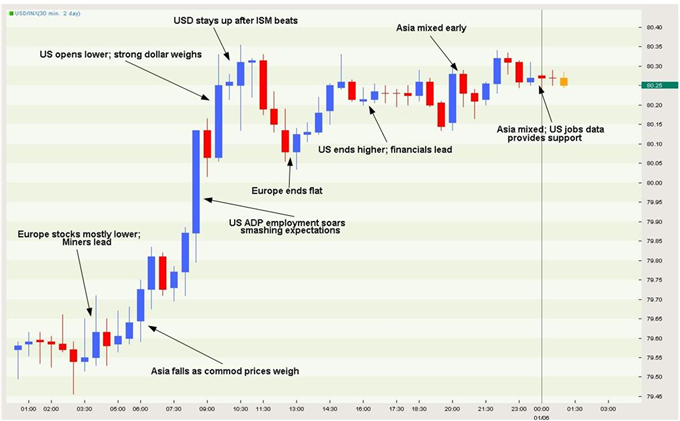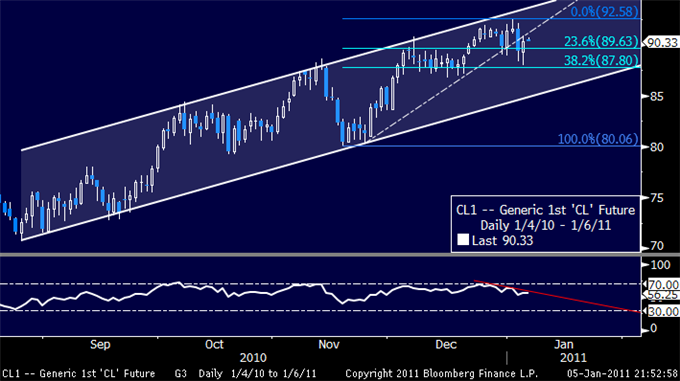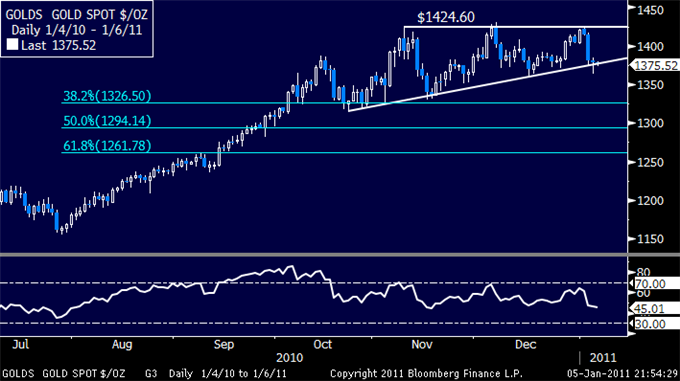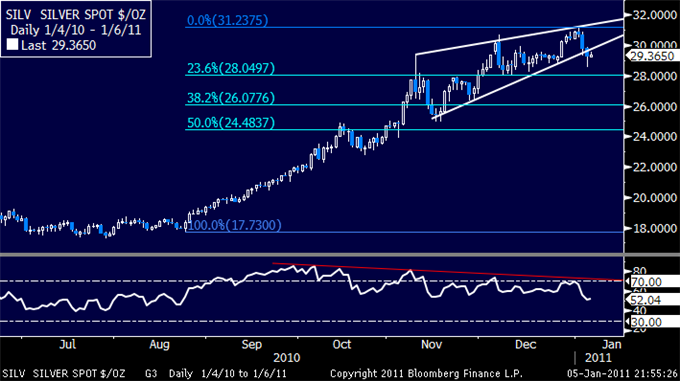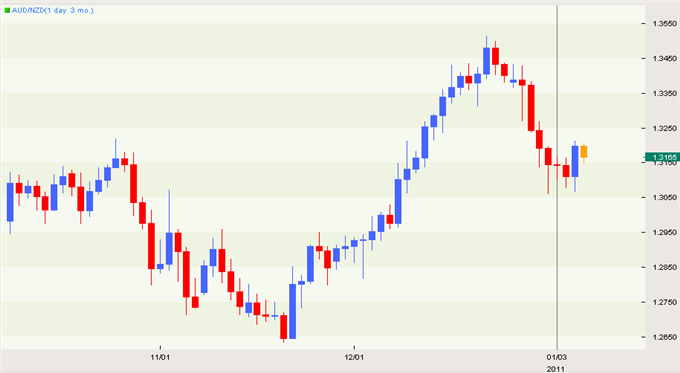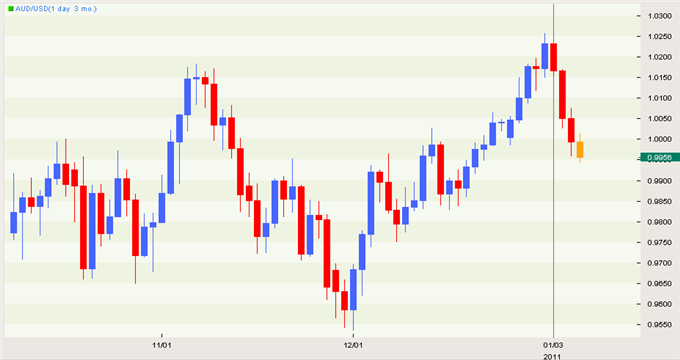- Dollar Extends its Biggest Rally in a Month with the Help of Strong Data and Confused Risk Trends
- Euro: Can China Fill in the Europe’s Financial Gaps Where the Market and EU Fall Short?
- Swiss Franc: What are the Implications of an SNB that Snubs Irish Debt?
- British Pound Not as Strong as EURGBP and GBPJPY Seem to Suggest
- Japanese Yen Plunge Continues with Select Pairs as Risk Trends Take up the Cause
- Australian Dollar May Suffer Materially for the Nation’s Flood
Dollar Extends its Biggest Rally in a Month with the Help of Strong Data and Confused Risk Trends
We can’t deny the dollar’s recent strength. Taking score, the greenback posted its biggest rally in three weeks against the euro, three-and-a-half months against the Japanese yen and 21 months against the Swiss franc. For the other majors, the dollar’s performance was a little more down to earth; but its consistency is enough to confirm the currency’s general strength. However, while we can’t refute the dollar’s recent strength; we do have reason to doubt the stability of this young trend. To form a true opinion of the fundamental outlook, it is important to once again look at the correlations (or lack thereof) between the different asset classes. Though currencies, equities, commodities and other securities are very different from one another in many aspects; they all fall under the scope of investor sentiment. As underlying risk appetite oscillates from one extreme to the other, capital flows naturally follow the same paths between safe haven and high yield assets. That said, a broader view of risk appetite would offer a confused picture. Both the Japanese yen and Swiss franc tumbled Wednesday alongside declines for the Australian and New Zealand dollars. At the same time, the benchmark S&P 500 has maintained its remarkably consistent climb. This mixed picture tells us that investor sentiment is not strong enough an influence at the moment to unify participants in the various markets. And, if this key driver is absent, what will keep the dollar buoyant?
There are fundamental catalysts other than risk appetite trends that can influence the greater flow of capital; but most of them exist only in unique market conditions. The appetite for return versus the fear of loss is elemental to all investment decisions; and that makes it a common denominator for all markets. As such, it is only a matter of time before clear moves in risk appetite once again take back the reins. In the meantime, speculators are leveraging their influence on the market. Feeding the recovery momentum that began Monday/Tuesday, the dollar found an accelerant in strong economic data. As little as a month, anything to encourage the outlook for a strong economic recovery would have leveraged investor confidence and subsequently hurt the safe haven US dollar. However, with the strong showings on the headline ISM non-manufacturing (services) sector and ADP employment reports, the S&P 500 would restrain its performance to the steadying trend of the past four months and the greenback would actually rally. The proprietary jobs report proved the more remarkable release when it reported payrolls rose by 297,000 through December. This was the biggest increase on record and three times the market consensus. If this were NFPs, the impact meaning and impact would be remarkable. Yet, despite their efforts, this indicator has not proven itself an accurate benchmark to the government figure. So, while excitement around NFPs has certainly increased; we should remain skeptical of the indicators outcome.
In contrast to the ADP figure, the service sector activity report likely carries more weight when it comes to forecasting economic activity. Accounting for roughly 80 percent of GDP, a true recovery will be founded in this sector. As such, the highest reading from the indicator since May 2006 (57.1) is an encouraging sign. On the other hand, US consumer spending is the foundation of everything; so a 2.2 percentage point drop in the measure’s employment gauge (50.5) contradicts the ADP report and obscures a bullish forecast.
Euro: Can China Fill in the Europe’s Financial Gaps Where the Market and EU Fall Short?
European Union financial problems cannot be wished away. However, they can be ignored for a while. That has been more or less the circumstances surrounding the currency through the past month as downgrades, nationalizations and discussion of debt restructuring crowded the headlines. Now, with liquidity filling back out and investors ready to allocate capital for 2011, we are waiting for a catalyst to reengage a euro trend. A modest upward revision in the region’s service sector index offers a weak argument for confidence. Far more concerning was Portugal’s six-month bond auction which drew a yield (their cost) of 3.686 percent. For perspective, they were paying 2.045 percent in September and 0.594 percent a year ago. Perhaps China’s recent interest in Greece, Spain and other EU countries’ debt can help stem the bleeding…
Swiss Franc: What are the Implications of an SNB that Snubs Irish Debt?
It was initial reported Tuesday and confirmed Wednesday that the SNB had announced it was no longer accepting Irish government debt as collateral for its repurchasing operations. The impact this has on the euro is relatively straightforward; but what does it mean for the franc? Well, destabilizing confidence in the shared currency only encourages the flow of capital to the safe haven franc.
British Pound Not as Strong as EURGBP and GBPJPY Seem to Suggest
The British pound was exceptionally strong Wednesday – that is against the euro, Swiss franc and Japanese yen. Yet, these currencies themselves were exceptionally weak. It seemed the currency’s performance was mixed on balance; and that is not unexpected given the lack of fundamental activity for the day. Only the construction activity report for December was on our radar and that is hardly a top tier indicator.
Japanese Yen Plunge Continues with Select Pairs as Risk Trends Take up the Cause
Like the euro and pound, the yen’s performance is mixed – though where it is falling, it does so with gusto. The economic docket is still relatively light; but Finance Minister Kan’s suggestion of growth killing tax hikes still stings. What’s more, the bullish performance of the Nikkei 225 this week is offering a domestic source of risk appetite flows – a burden to a funding currency.
Australian Dollar May Suffer Materially for the Nation’s Flood
Just how influential is the flood in Australia to its economy and currency? RBA member McGauchie suggested it could be “significant” as exports are hurt in the short-term and infrastructure is destroyed in the medium-term. What does this mean for currency traders? A tempered pace of growth and a reason for the central bank to further ease up on rate hikes.
ECONOMIC DATA
Next 24 Hours
| Currency | GMT | Release | Survey | Previous | Comments |
| AUD | 22:30 | AiG Performance of Service Index (DEC) | | 46.2 | Index hasn't gained consecutive months since Feb-March. |
| AUD | 0:30 | Building Approvals (MoM) (NOV) | -4.0% | 9.3% | Signs of eroding Aussie housing market beginning to show. |
| AUD | 0:30 | Building Approvals (YoY) (NOV) | -9.8% | 1.2% |
| CHF | 8:00 | Foreign Currency Reserves (DEC) | | 212.4B | Should drop as Franc strengthened. |
| CHF | 8:15 | Consumer Price Index (MoM) (DEC) | -0.1% | 0.2% | Deflation could spur intervention rumors. |
| CHF | 8:15 | Consumer Price Index (YoY) (DEC) | 0.4% | 0.2% |
| GBP | 9:30 | Purchasing Manager Index Services (DEC) | 52.8 | 53.0 | Steady growth expected. |
| EUR | 10:00 | Euro-Zone Economic Confidence (DEC) | 105.8 | 105.3 | Most Euro-confidence indicators expected to rise, though could be short-lived optimism as sovereign debt problems have begun to resurface. |
| EUR | 10:00 | Euro-Zone Business Climate Indicator (DEC) | 1.00 | 0.96 |
| EUR | 10:00 | Euro-Zone Consumer Confidence (DEC) | -10.5 | -9.4 | |
| EUR | 10:00 | Euro-Zone Industrial Confidence (DEC) | 2.0 | 0.9 | |
| EUR | 10:00 | Euro-Zone Services Confidence (DEC) | 10.1 | 10.2 | |
| EUR | 10:00 | Euro-Zone Retail Sales (MoM) (NOV) | 0.2% | 0.3% | Sales likely to be boosted again by German consumption. |
| EUR | 10:00 | Euro-Zone Retail Sales (YoY) (NOV) | 2.1% | 1.3% |
| EUR | 11:00 | German Factory Orders s.a. (MoM) (NOV) | 1.0% | 1.6% | Decline in orders likely as domestic demand tapers off. |
| EUR | 11:00 | German Factory Orders n.s.a. (YoY) (NOV) | 15.8% | 17.9% |
| USD | 13:30 | Initial Jobless Claims (JAN 1) | 400K | 388K | Labor market expected to continue recent recovery momentum. |
| USD | 13:30 | Continuing Claims (DEC 25) | 4080K | 4128K |
| CAD | 15:00 | Ivey Purchasing Managers Index (DEC) | 53.3 | 57.5 | Could outpace survey as Canadian economy heats up. |
| USD | 21:00 | RPX Composite 28 Day (YoY) (OCT) | | -1.86% | Index could break above 190.00 for first time since August. |
| USD | 21:00 | RPX Composite 28 Day Index (OCT 31) | | 189.21 |
| | | | | | |
| Currency | GMT | Upcoming Events & Speeches | | | |
| EUR | -:- | Italian Market Closed For Epiphany | | | |
SUPPORT AND RESISTANCE LEVELS
CLASSIC SUPPORT AND RESISTANCE - 18:00 GMT
| Currency | EUR/USD | GBP/USD | USD/JPY | USD/CHF | USD/CAD | AUD/USD | NZD/USD | EUR/JPY | GBP/JPY |
| Resist 2 | 1.3840 | 1.6420 | 89.00 | 1.0000 | 1.0922 | 1.0600 | 0.8230 | 127.60 | 146.05 |
| Resist 1 | 1.3700 | 1.5910 | 86.00 | 0.9735 | 1.0750 | 1.0200 | 0.8000 | 120.00 | 140.00 |
| Spot | 1.3155 | 1.5511 | 83.26 | 0.9658 | 0.9963 | 0.9999 | 0.7579 | 109.52 | 129.14 |
| Support 1 | 1.3000 | 1.5312 | 80.00 | 0.9300 | 0.9950 | 0.9600 | 0.6850 | 103.80 | 125.00 |
| Support 2 | 1.2925 | 1.5186 | 75.00 | 0.9000 | 0.9700 | 0.9375 | 0.6585 | 100.00 | 119.00 |
CLASSIC SUPPORT AND RESISTANCE –EMERGING MARKETS 18:00 GMTSCANDIES CURRENCIES 18:00 GMT
| Currency | USD/MXN | USD/TRY | USD/ZAR | USD/HKD | USD/SGD | | Currency | USD/SEK | USD/DKK | USD/NOK |
| Resist 2 | 14.4500 | 1.6755 | 7.1750 | 7.8165 | 1.4945 | | Resist 2 | 7.7500 | 5.7800 | 6.2750 |
| Resist 1 | 13.8500 | 1.5931 | 6.7650 | 7.8075 | 1.4655 | | Resist 1 | 7.5800 | 5.6625 | 6.1150 |
| Spot | 12.1906 | 1.5448 | 6.7032 | 7.7705 | 1.2919 | | Spot | 6.7659 | 5.6651 | 5.9014 |
| Support 1 | 12.0500 | 1.4724 | 6.4000 | 7.7490 | 1.2750 | | Support 1 | 6.4500 | 5.2625 | 5.7030 |
| Support 2 | 11.7200 | 1.3475 | 5.9200 | 7.7450 | 1.2500 | | Support 2 | 6.1250 | 5.1000 | 5.5200 |
INTRA-DAY PIVOT POINTS 18:00 GMT
| Currency | EUR/USD | GBP/USD | USD/JPY | USD/CHF | USD/CAD | AUD/USD | NZD/USD | EUR/JPY | GBP/JPY |
| Resist 2 | 1.3401 | 1.5707 | 84.33 | 0.9820 | 1.0062 | 1.0127 | 0.7718 | 110.49 | 130.30 |
| Resist 1 | 1.3278 | 1.5609 | 83.80 | 0.9739 | 1.0013 | 1.0063 | 0.7648 | 110.01 | 129.72 |
| Pivot | 1.3202 | 1.5530 | 82.84 | 0.9604 | 0.9973 | 1.0012 | 0.7612 | 109.26 | 128.59 |
| Support 1 | 1.3079 | 1.5432 | 82.31 | 0.9523 | 0.9924 | 0.9948 | 0.7542 | 108.78 | 128.01 |
| Support 2 | 1.3003 | 1.5353 | 81.35 | 0.9388 | 0.9884 | 0.9897 | 0.7506 | 108.03 | 126.88 |
INTRA-DAY PROBABILITY BANDS 18:00 GMT
\
| Currency | EUR/USD | GBP/USD | USD/JPY | USD/CHF | USD/CAD | AUD/USD | NZD/USD | EUR/JPY | GBP/JPY |
| Resist. 3 | 1.3345 | 1.5689 | 84.24 | 0.9783 | 1.0072 | 1.0147 | 0.7695 | 111.18 | 130.96 |
| Resist. 2 | 1.3297 | 1.5644 | 83.99 | 0.9752 | 1.0045 | 1.0110 | 0.7666 | 110.76 | 130.50 |
| Resist. 1 | 1.3250 | 1.5600 | 83.75 | 0.9720 | 1.0017 | 1.0073 | 0.7637 | 110.35 | 130.05 |
| Spot | 1.3155 | 1.5511 | 83.26 | 0.9658 | 0.9963 | 0.9999 | 0.7579 | 109.52 | 129.14 |
| Support 1 | 1.3060 | 1.5422 | 82.77 | 0.9596 | 0.9909 | 0.9925 | 0.7521 | 108.69 | 128.23 |
| Support 2 | 1.3013 | 1.5378 | 82.53 | 0.9564 | 0.9881 | 0.9888 | 0.7492 | 108.28 | 127.78 |
| Support 3 | 1.2965 | 1.5333 | 82.28 | 0.9533 | 0.9854 | 0.9851 | 0.7463 | 107.86 | 127.32 |
v
Written by: John Kicklighter, Currency Strategist for DailyFX.com
To receive John’s reports via email or to submit Questions or Comments about an article; email jkicklighter@dailyfx.com
http://www.dailyfx.com/calendar
